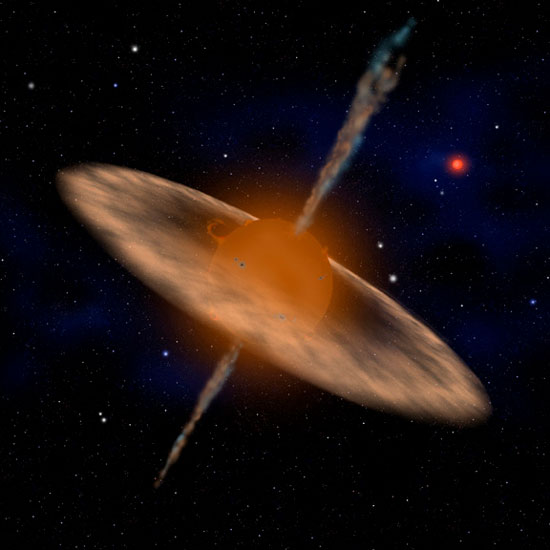Further evidence of brown dwarf origin was found
An international team of scientists, including Dr. Phan Bao Ngoc - International University - Ho Chi Minh City National University (team leader) and astronomers from Taiwan Astronomical Institute, Astronomical Center Physics (CfA) - Harvard University (USA) has discovered the phenomenon of bipolar carbon monoxide release from a very low-mass young MHO 5 star, in the Taurus star-forming region.
This is evidence that extremely low mass stars such as brown dwarfs or high-mass planets can be formed in the usual way of solar-mass stars.

The illustration of a brown dwarf is formed as an ordinary star: Absorbing material from the accretion disk, liberating angular torque by firing matter rays in opposite directions, these rays interacting with gas molecules from the surrounding environment to create a phenomenon of polarizing CO molecules (Photo: David A. Aguilar, CfA - Harvard ).
This discovery is the result of a research program aimed at detecting and characterizing the phenomenon of polarizing CO molecules in brown dwarfs using radio telescopes. The program funded by Vietnam National Science and Technology Development Fund (NAFOSTED) to support Dr. Phan Bao Ngoc to continue implementing the research program in Vietnam, after the group's first discovery of the phenomenon This is the ISO-Oph 102 brown dwarf in the Ophiuchi star formation .
Brown dwarfs range in mass from 15 to 75 times Jupiter so they are not heavy enough to carry out nuclear reactions that burn hydrogen like normal stars with larger masses, such as the Sun. In terms of mass, brown dwarfs lie between normal stars and planets. According to the theory of star formation, molecular release of CO is a characteristic phenomenon in the formation of stars from the collapse and collapse of molecular clouds with a sufficiently large mass under the effect of gravity.
However, brown dwarfs have too small masses so it is difficult to explain in the above way. Therefore, for nearly two decades, many scenarios of brown dwarf formation have been proposed. One such scenario is brown dwarfs formed as larger mass stars through gravitational collapse and fragmentation of molecular clouds. Recent observations show that the physical properties of brown dwarfs and ordinary stars are similar and therefore support the hypothesis.
MHO 5 is a very low mass star, about 90 times Jupiter (ie 9/100 solar masses), in terms of the mechanism of forming extremely low mass stars, brown dwarfs are thought to be shaped. follow the same scenario. Along with the first discovery of this phenomenon of the group (end of 2008) in the brown dwarf ISO-Oph 102 of the Ophiuchi region, the detection of the release of CO in MHO 5 in the Taurus region mentioned above allows the Astronomers characterize the basic physical parameters of this phenomenon in different star-forming regions. Thereby, this is also the second evidence that this phenomenon is widespread, thus proving that the process of forming brown dwarfs is similar to that of larger stars but with the model. shrink from hundreds to thousands of times .
Another important discovery of that group was the crystallization detection of matter on the MHO 5 accretion disk based on observational data of Spitzer space infrared glasses. The process of material crystallization is understood as the initial step for the formation of planets around stars. The fact that the planets begin to form on the accretion disk while the process of releasing gas is still active will push the gas away from the disk, facilitating the formation of low-gas planets, many stones and stones like the Left. land. This discovery is an important guide in hunting Earth-like planets around extremely low mass stars such as brown dwarfs.
The results of the study will be published in The Astrophysical Journal, June, 2011.
- Amazingly explore the mysterious nature of brown dwarfs
- Find the coolest brown dwarf
- Discover the astonishment of the planet's formation
- Accompanying farmers in preventing brown backed rice plant hoppers, yellow dwarf diseases, twisted leaves dwarf diseases
- Detecting the youngest and smallest mass dwarf in the vicinity of the Sun.
- Discovering the secret of life in brown dwarfs
- New set of photos about the dwarf planet Makemake
- For the first time detected foreign clouds of the Solar System
- The polar bear again collides with the brown bear
- Rare dwarf elephants die in mass
- Smoke brown covered the sky, people panicked aliens attack
- NASA discovered mysterious ice volcanoes on dwarf planet Ceres
 Van Allen's belt and evidence that the Apollo 11 mission to the Moon was myth
Van Allen's belt and evidence that the Apollo 11 mission to the Moon was myth The levels of civilization in the universe (Kardashev scale)
The levels of civilization in the universe (Kardashev scale) Today Mars, the sun and the Earth are aligned
Today Mars, the sun and the Earth are aligned The Amazon owner announced a secret plan to build a space base for thousands of people
The Amazon owner announced a secret plan to build a space base for thousands of people